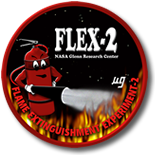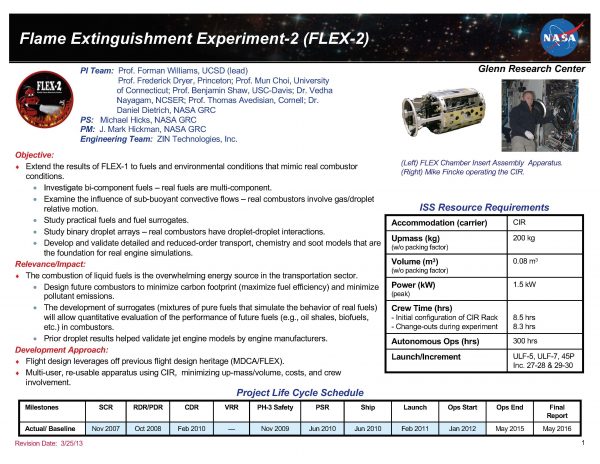FLEX-2
Flame Extinguishment Experiment-2 (FLEX-2)

The second in the FLEX series of experiments, the FLEX-2 investigation uses fuels and environmental conditions that mimic real combustor conditions. The investigation will extend and advance the research into droplet combustion, studying the influence of sub-buoyant convective flows on combustion rates, determining the influence of a second burning droplet on a linear array, and beginning the study of practical fuels by burning bi-component and surrogate fuels. As the research extends into increasingly complex fuels, FLEX-2 data can help verify models of real fuels used in transportation and industry. Results of the FLEX-2 experimental data will help to develop verified detailed and reduced-order models of droplet combustion, particularly with flow-field and droplet-droplet interactions.
The spherically symmetric combustion of a liquid fuel droplet in a quiescent oxidizing atmosphere is a classical problem in combustion research. The advantage of the spherical symmetry is that only one spatial dimension enters the description of the combustion process. This greatly simplifies the mathematics required for modeling combustion processes. Microgravity experiments provide the opportunity to achieve this spherical symmetry, a fact which NASA has used to its advantage in fundamental investigations for a number of years. The Fundamental Studies in Droplet Combustion and Flame Extinguishment in Microgravity (FLEX-2) investigation touches on a number of far-reaching combustion phenomena that can be uniquely addressed through the idealized geometry of a droplet burning in microgravity.
Studies of the liquid-phase mixing of the different components in fuels clarifies the way practical fuels turn to gas from liquid in the combustion process. Understanding soot formation during the combustion of liquid fuels is also studied. These studies are important due to soot’s negative effects on the environment and on human health. Knowledge of soot formation also has practical uses in certain industrial processes. The interactions of droplets with their gaseous environments and with other droplets are studied to reveal the fundamental dynamics of combustion.
In the absence of gravity, small droplets of fuel (i.e., from 2 mm to 4 mm in diameter) burn “one-dimensionally”, which means the flame will be shaped a like ball about the size of a large olive that will be centered around the droplet. This one-dimensional nature of the droplet flame allows the science team to easily measure and understand important features of the burning fuel that would otherwise be impossible to obtain on the ground. This particular type of flame configuration allows measurement and observation of very complex interactions in a spherically one-dimensional system, providing insights into the behavior of combustion phenomena that would otherwise be difficult, if not impossible, to obtain in multi-dimensional systems that are typically found in most 1-g fires.
The Fundamental Studies in Droplet Combustion and Flame Extinguishment in Microgravity – 2 (FLEX-2) experiments involve dispensing, deploying and igniting either a single droplet or a pair of droplets, depending on the experiment configuration, in a known and controlled gaseous environment. The ignited droplets either burn to completion or the flame extinguishes at a finite droplet radius in a quiescent ambient. During the experiments involving binary droplet arrays, two droplets are placed along a support fiber at known locations and the droplets are ignited simultaneously and the subsequent burning is recorded. In the convective flow tests, a single droplet is subjected to a known and controlled sub-buoyant flow of the quiescent atmosphere around the droplet. The flow is realized when the droplet is tethered to a substrate. In this tethered mode the droplet is placed at the intersection of two fiber cross-hairs. The cross hairs are then moved through the quiescent atmosphere surrounding the droplet.
The experiments in FLEX-2 can easily be categorized into four separate groupings; these being, the pure fuel experiments, the fuel mixture experiments, the convective flow experiments, and the binary droplet array experiments. Each of these groupings are sponsored by one or more investigators comprising the investigation team and entail anywhere from 30 to 60 separate tests using different fuels, different ambient conditions, or different droplet configurations.
Related Documents
Currently updating…
Publications
Currently updating…
Contact Information
PI Team: Prof. Forman Williams, UCSD (lead)
Prof. Frederick Dryer, Princeton;
Prof. Mun Choi, University of Connecticut;
Prof. Benjamin Shaw, USC-Davis;
Dr. Vedha Nayagam, NCSER;
Prof. Thomas Avedisian, Cornell;
Dr. Daniel Dietrich, NASA GRC
PS: Michael Hicks, NASA GRC
PM: J. Mark Hickman, NASA GRC
Engineering Team: ZIN Technologies, Inc.

